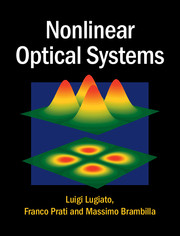Book contents
- Frontmatter
- Dedication
- Contents
- Preface
- Part I Models, propagation, stationary phenomena
- Part II Dynamical Phenomena, Instabilities, Chaos
- 18 Some general aspects in nonlinear dissipative dynamical systems
- 19 Special limits in the single-mode model
- 20 The linear-stability analysis of the Maxwell–Bloch equations
- 21 Adiabatic elimination in the complete Maxwell–Bloch equations
- 22 Dynamical aspects in the laser
- 23 Single-mode and multimode operation in inhomogeneously broadened lasers
- 24 Dynamical aspects in optical bistability
- 25 Self-pulsing in other optical systems
- Part III Transverse optical patterns
- Appendix A The Routh–Hurwitz stability criterion
- Appendix B Calculation of the oscillatory instability boundary
- Appendix C Coefficients of the characteristic equation (20.20)
- Appendix D Derivation of equations (20.27) and (20.28)
- Appendix E Coefficients of equations (20.60) and (20.61)
- Appendix F The exact boundary of the Risken–Nummedal–Graham–Haken instability
- Appendix G Nonlinear analysis of the roll solution
- References
- Index
24 - Dynamical aspects in optical bistability
from Part II - Dynamical Phenomena, Instabilities, Chaos
Published online by Cambridge University Press: 05 March 2015
- Frontmatter
- Dedication
- Contents
- Preface
- Part I Models, propagation, stationary phenomena
- Part II Dynamical Phenomena, Instabilities, Chaos
- 18 Some general aspects in nonlinear dissipative dynamical systems
- 19 Special limits in the single-mode model
- 20 The linear-stability analysis of the Maxwell–Bloch equations
- 21 Adiabatic elimination in the complete Maxwell–Bloch equations
- 22 Dynamical aspects in the laser
- 23 Single-mode and multimode operation in inhomogeneously broadened lasers
- 24 Dynamical aspects in optical bistability
- 25 Self-pulsing in other optical systems
- Part III Transverse optical patterns
- Appendix A The Routh–Hurwitz stability criterion
- Appendix B Calculation of the oscillatory instability boundary
- Appendix C Coefficients of the characteristic equation (20.20)
- Appendix D Derivation of equations (20.27) and (20.28)
- Appendix E Coefficients of equations (20.60) and (20.61)
- Appendix F The exact boundary of the Risken–Nummedal–Graham–Haken instability
- Appendix G Nonlinear analysis of the roll solution
- References
- Index
Summary
Although the discovery of oscillatory instabilities (both single-mode and multimode) in free-running lasers was achieved in the 1960s, investigations on oscillatory instabilities in optical bistability did not take place until the 1970s and 1980s.
The first section of this chapter does not deal with oscillatory instabilities, but instead concerns an interesting dynamical phenomenon in optical bistability that arises when the input field approaches a boundary of the bistable domain, and is called critical slowing down. This has been investigated both theoretically and experimentally.
The remainder of this chapter is entirely devoted to oscillatory instabilities, following a historical order. With an inverse approach with respect to the laser case, we discuss multimode instabilities first. In Section 24.2.1 we start with the description of the instability which arises under exactly resonant conditions. While this is the counterpart in optical bistability of the resonant multimode laser instability discussed in Section 22.5, a striking difference from the laser case is that in the passive configuration there is no corresponding single-mode instability. This difference disappears, however, when we consider the generalization of the multimode instability of optical bistability to the detuned configuration. Finally we show that in the detuned case it has been possible to achieve a convincing experimental observation of the multimode instability in a long microwave cavity.
After some relevant miscellaneous considerations in Section 24.2.2, in Section 24.2.3 we address the subject of the multimode Ikeda instability which leads to period doubling and chaos and aroused a lot of interest in optical chaos. We emphasize also the intrinsic connections with the standard multimode instability discussed in Section 24.2.1, showing, in particular, that the Ikeda instability requires conditions far from the low-transmission limit, i.e. that ∝L is not small.
In Section 24.3 we discuss single-mode instabilities in optical bistability. In Section 24.3.1 we illustrate a configuration for the single-mode instability that includes also the Gaussian shape of the electric field in the beam section, and leads to periodic, close-to-sinusoidal self-pulsations.
- Type
- Chapter
- Information
- Nonlinear Optical Systems , pp. 288 - 305Publisher: Cambridge University PressPrint publication year: 2015



